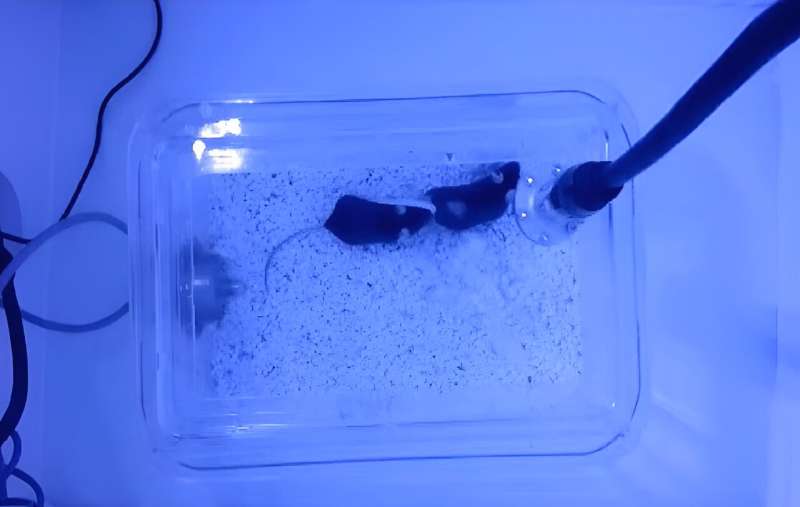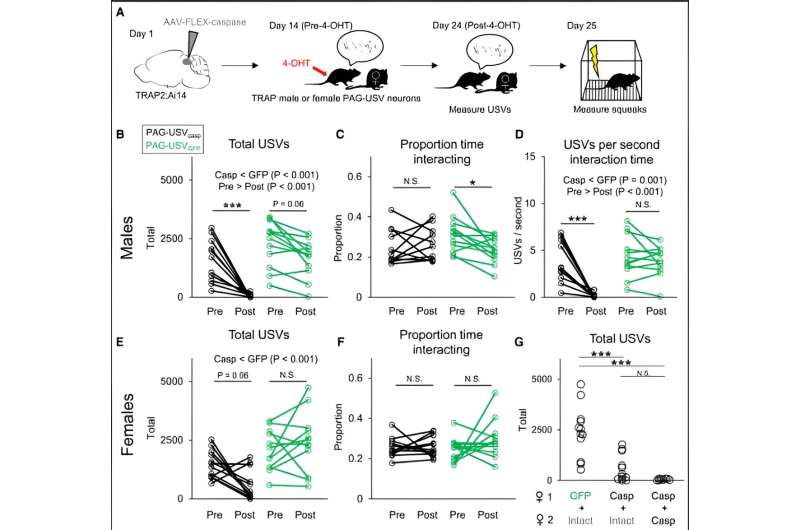This article has been reviewed according to Science X's editorial process and policies. Editors have highlighted the following attributes while ensuring the content's credibility:
fact-checked
peer-reviewed publication
trusted source
proofread
Mouse social calls and distress calls are linked to different neurons, new research shows

Cornell neuroscientists have identified a group of midbrain neurons essential to social vocalizations produced by mice—but not the squeaks they make when distressed.
The findings suggest that in mice, and likely other animals, different populations of midbrain neurons control different types of vocalizations, rather than a single multitasking set.
A better understanding of how the brain is organized to control vocalization including human speech could reveal how genetic disorders or illness can damage those neural circuits, and improve treatments.
"Vocal communication is central to our experience as humans and fundamental to social success for animals generally," said Katherine Tschida, the Mary Armstrong Meduski '80 Assistant Professor in the Department of Psychology, in the College of Arts and Sciences. "We're beginning to uncover in a detailed way how different populations of neurons contribute to specific aspects of our vocal behaviors."
Tschida is the corresponding author of "Midbrain Neurons Important for the Production of Mouse Ultrasonic Vocalizations Are Not Required for Distress Calls," published Jan. 31 in Current Biology. First author Patryk Ziobro, a doctoral student in the field of psychology, and co-authors Yena Woo and Zichen He are current and former members of the Tschida Lab.
Scientists have known for decades that a part of the midbrain called the periaqueductal gray (PAG) is essential for vocal production, which could include a cat's meow or hiss, a person's laugh or cry, or the emotional content of our speech. That knowledge has remained at the regional level, Tschida said, without the ability to selectively manipulate neurons responsible for vocalization.
Mice mainly communicate in two ways: human-audible squeaks when experiencing pain or fear; and higher-frequency ultrasonic vocalizations (USVs) used during courtship and other social interactions. In 2019, a Tschida-led team reported that destroying a particular group of PAG neurons muted males' ultrasonic communication, raising the question of whether those neurons might control vocalizations in other contexts.
The new research replicated the earlier study's finding in males and extended it to females. Lacking what the researchers labeled PAG-USV neurons, the mice could still engage in social and courtship activities, but did so silently.
The team then set out to see if the neurons' absence also limited mice's ability to squeak. Applying mild shocks to the study subjects' feet—enough to elicit squeaks but cause no physical harm—the researchers discovered the distress calls were unaffected.
"The fact that you can eliminate one type of vocalization without perturbing the other is pretty clear evidence that there must be different neurons in the brain regulating these two types of vocal communication," Tschida said.

The scenario could be more complex in animals with richer vocal repertoires, Tschida said, including in humans. But the research appears to rule out simple models suggesting that one population of neurons is behind all of it.
That's a step, Tschida said, toward building a more detailed mechanistic picture that explains how specific PAG neurons function and how interactions with downstream neurons in the hindbrain allow animals to vocalize at the right time and in the right way. And, the researchers said, it's a step toward understanding why neurological and neurodevelopmental disorders may impair vocalization.
"In cases where that impairment is more related to motor control, we don't have a clear understanding of what causes people to have difficulty in developing and regulating speech," Tschida said. "Having that basic level of understanding about how the brain generates vocalizations can help us understand when something goes wrong, how did it go wrong?"
Interestingly, Tschida said, the study also showed that different neurons are responsible for vocalizations conveying positive and negative emotional states in mice, potentially another avenue for research. In ongoing work, the team hopes to identify the neurons that regulate squeak production.
"Knowing there are different populations of neurons for USVs and squeaks opens up a whole new set of experiments diving into the neural mechanisms of those vocalizations," Ziobro said. "I'm looking forward to the next steps."
More information: Patryk Ziobro et al, Midbrain neurons important for the production of mouse ultrasonic vocalizations are not required for distress calls, Current Biology (2024). DOI: 10.1016/j.cub.2024.01.016
Journal information: Current Biology
Provided by Cornell University

















